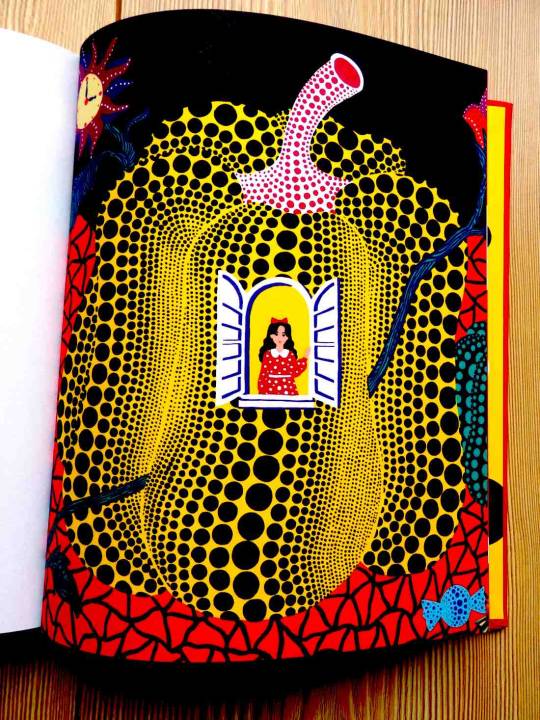Don't wanna be here? Send us removal request.
Photo










Alice’s Adventures in Wonderland without Disneyland
Alice’s Adventures in Wonderland by Lewis Carroll (author) and Yayoi Kusama (illustrator) Penguin UK 2012, 192 pages, 7.5 x 8.8 x 0.9 inches $23 Buy a copy on Amazon
You must have some trepidation when you set out to illustrate a story as iconic as Alice in Wonderland. What effect can you offer that isn’t already achieved by the classic words themselves? From the myriad images contained within the story, how do you choose what to illustrate and what to leave out? And when everyone’s idea of Alice is already so wrapped up in the Disney version, can you really expect anyone to embrace your vision instead?
Thankfully, Yayoi Kusama doesn’t shy from the task and in the process has accomplished something beautiful and thoroughly undisneyfied. The illustrations aren’t designed to help you visualise Alice’s world as if it were real, but rather to exhibit it in all its un-realness. Kusama’s dreamy polka dots pattern each page while bold colours and abstract mosaics challenge everything you thought you knew about Lewis Carroll’s story. Frequently the illustrations require a double take: are you looking at something that’s close and microscopic, or far away but gargantuan? Even the text of the story is welded into Kusama’s artistic vision, growing and shrinking, hiding amid the illustrations, getting eaten by fish and winding around mushrooms. The book just gets curiouser and curiouser.
“Begin at the beginning,” the King tells Alice in the story, “and go on till you come to the end: then stop.” Easier said than done, King – because with such lush illustrations on display, reaching the end isn’t a guarantee of anything. It’s only going to make you want to go right back to the start. – Damien McLaughlin
November 27, 2015
33 notes
·
View notes
Photo

Currently listening to 'Ne Me Jugez Pas (Volodia Remix)' by Sawt El Atlas on AccuRadio.com
#Ne Me Jugez Pas (Volodia Remix)#accuradio#Sawt El Atlas#radio#music#free music#internet radio#webcast
0 notes
Photo

Gargoyle faces and witch-like masks adorn the walls of Yoon Ji Seon’s first US solo exhibition, Rag Face, at the Yossi Milo Gallery, New York. Contorted, maimed, and muffled, these bodiless heads beckon as much as they repulse. On closer inspection, it’s apparent that most of these faces, making up the Rage Face series, are Yoon’s self-portraits. Alternating between the traditional use of masks in her native South Korea, and Cindy Sherman’s constructed identity, the concept of self-portraiture is dismantled in Yoon’s works.
Grotesque, Sewn Self-Portraits Pervert Norms of Female Beauty
45 notes
·
View notes
Photo

“The Tantric Dance is inspired by the union of Feminine and Masculine power. In the Yogic tradition, the goddess Kali is revered as the fierce mother of Time, Change, and Destruction. In her mythology, Kali is the slayer of demons, dancing with such joyful ferocity that she nearly Destroys the universe. Kali is calmed when she touches the balancing energy of Shiva, who radiates the deepest peace of meditation and Self-realization, covered by the white ashes of the cremation ground and bearing a drum. Shiva is also hailed as a dancer, often depicted in the Nataraja pose as ‘Lord of the Cosmic Dance,’ who Creates the Universe through his movement and vibration. Nataraja is usually shown standing upon a small figure, representing conquered ignorance. In my artwork, Nataraja Ardhanarishvara stands triumphant atop the outdated systems of greed, represented by a major urban financial district, vanquishing the illusion of scarcity with the brilliant light of creative expression. When scarcity is banished, our creative energies can truly flourish, ushering in a new golden era of abundance for all.
As we dance the story of our lives, may this piece inspire your inner balance of masculine and feminine power, of forces both destructive and creative, both in relationship and within. Jai Shiva Shakti.”
Buy Print
6 notes
·
View notes
